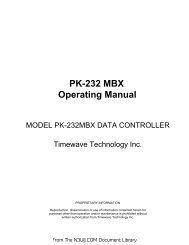TH-D72A/E - N3UJJ
TH-D72A/E - N3UJJ
TH-D72A/E - N3UJJ
Create successful ePaper yourself
Turn your PDF publications into a flip-book with our unique Google optimized e-Paper software.
7 APRS NETWORKS7.4 Digipeaters (Digital Repeaters)The greatest feature of APRS is the network that is spreading around the world. The heart of thenetwork is made up of many digital repeaters commonly referred to as digipeaters. Of course,digipeaters are well-known among those who have used packet radio for years. Digipeaters receivedata over-the-air via radio signal and repeat or relay it onward. For a voice repeater, two differentfrequencies are used simultaneously to accomplish this repeater function. However, a digipeater firstreceives and stores data, and then transmits when the channel clears.In the earlier times of packet radio and digipeaters, it was required to specify the callsign of eachdigipeater station. But it was difficult to know which digipeater station to use. If moving in a vehicle,you had to constantly consider changing digipeaters. Now, APRS uses a common generic callsignfor all digipeaters referred to as WIDEn-N, where N is the number of hops desired through thenetwork (typically 2 or less). The WIDE terminology lets you know the digipeater is in a good locationfor repeating signals. A mobile station anywhere only has to specify WIDE1-1 without needing toknow a specific callsign of a digipeater in order to digipeat their beacon transmission.APRS evolved over many years beginning in 1992, and there were many inefficient older networkconcepts that were still being used in some areas. You still may see references to these obsoletetechniques (RELAY, WIDE, TRACE, and TRACEn-N). By 2004, it was decided it was time toabandon those many older inefficient paths and concentrate on only the fully traceable WIDEn-Nalgorithm. The APRS network was universally upgraded to just the one simple and traceableWIDEn-N concept. This operating standard was called the New-N Paradigm. Since its adoption,most areas have seen many improvements in local area APRS reliability. In most areas, the numberof hops should be no more than 2 hops. This was because additional hops just add too muchnetwork load and too much interference from stations far away.The following sections explain configuration of the <strong>TH</strong>-<strong>D72A</strong>/E for use with digipeaters.7.4.1 UIDIGIWith UIDIGI activated (On), when a digipeater receives a UI frame with a character string for alias(such as RELAY, WIDE1-1, etc.) that matches the alias character string in the digipeater, thedigipeater repeats the packet substituting the callsign from the digipeater’s My Callsign configurationand adding a completed flag ( ).UIDIGI should normally be off. It is not good for mobiles to be digipeating all packets on the channelbecause it causes much interference. But sometimes, in special cases, when a mobile is being usedon top of a hill or in a special weak area to provide temporary emergency digipeating, then UIDIGIcan be enabled with the WIDE1-1 alias so that this mobile can serve as the first hop out of an area.In this case, the mobile station operates as the first hop of the first relay station for this area. WIDE1-1 digipeating only operates on the first hop, so there is not much damage to the network or to othertraffic.WB4APR-7 > APK103,WIDE1-1, WIDE2-1: TestWB4APR-7 > APK103,W6DJY-1*, WIDE2-1: TestMy callsign: W6DJY-1UIdigi: ONAliases: WIDE1-1Figure 7-5 Using UIDIGI<strong>TH</strong>-<strong>D72A</strong>/E CONTENTS 57From The <strong>N3UJJ</strong>.COM Document Library
















